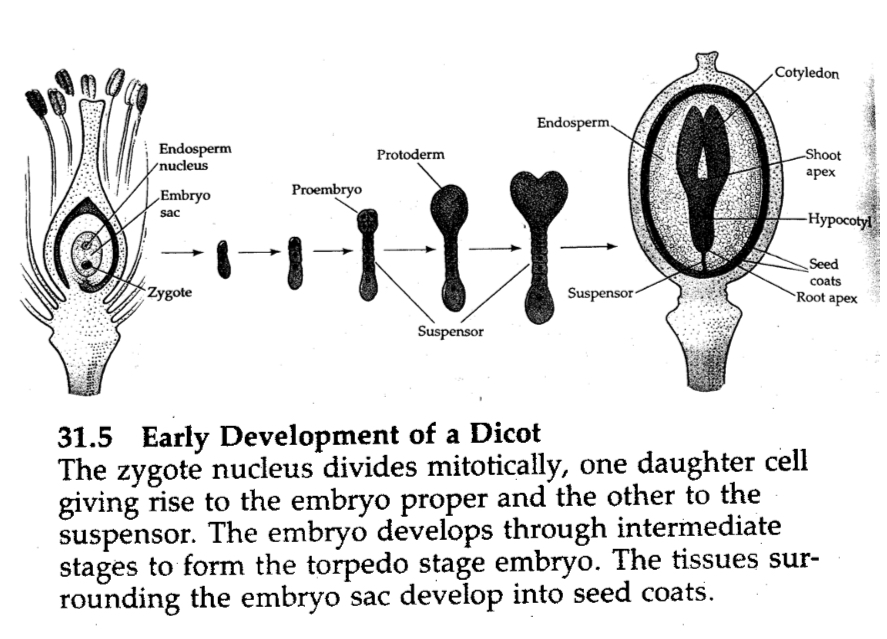everything plant exam 4
1/78
There's no tags or description
Looks like no tags are added yet.
Name | Mastery | Learn | Test | Matching | Spaced |
|---|
No study sessions yet.
79 Terms
Biodiversity
-Richness of species in an environment
-Biodiversity increases because species have a way of multiplying (speciation)
Speciation
-Formation of new species
-Main way in plants is allopathic speciation: Species form in different areas
-Two separate models: Vicariance model (top) and Dispersal model (bottom)
-Ex of Vicariance model: Geographic range of a species is split by barrier, and two isolated sub populations evolve separately
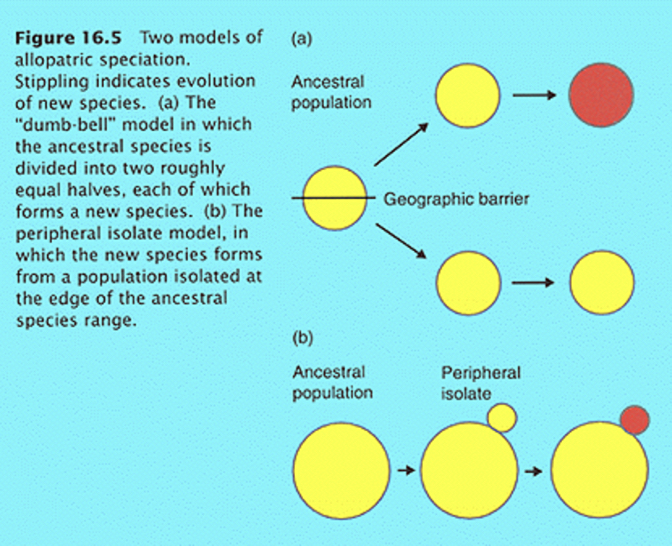
Speciation might work for a wildflower
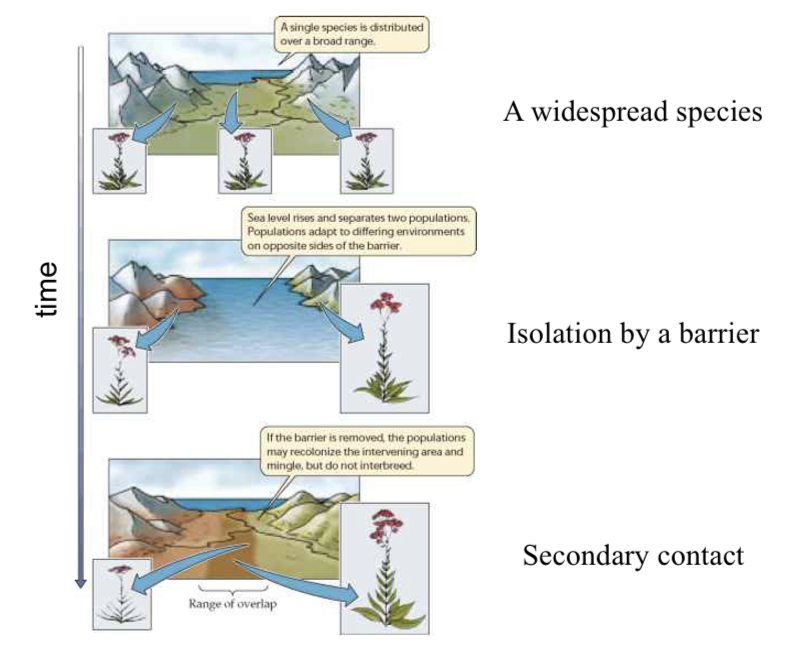
Allopathic speciation
-In general, populations become reproductively isolated by a barrier (no gene exchange) and those populations diverge as they adapt to different environments, which could take thousands of years.
-If those populations come back into contact (perhaps millions of years later) they can no longer interbreed
-Therefore, defined as a different species
-Often, sister species are different ecologically, ex: could live in different habitats and be adapted to different soil
Temporal isolation
-Two groups of a population exhibit different times of breeding
-One the most effective ways to be reproductively isolated is to flower at different times
Incomplete speciation
-If speciation is incomplete (two populations can interbreed on contact) might called the two separate but distinct populations subspecies
Genetic Drift: Bottleneck Effect
-In plants, founding population could be as small as one spore or one seed
-This small founding population represents a huge reduction in the genetic variability of the new population
-Also might be susceptible to rapid genetic drift, or random changes in allele frequencies

Founder effect
-Rapid evolutionary change due to a genetic bottleneck, genetic drift, and strong natural selection in a new environment
Summary of two models: Dispersal vs Vicariance models

Adaptive radiation
-Relatively fast evolution of one species into a number of distinct but related species
Each new species fills a previously empty ecological niche
-Due to repeated speciation events, where numerous species result
-Over time, species can diversify and adapt to very different environments
Sympathetic speciation (polyploidy)
-Type of speciation that does not require geographic isolation
-Usually in the form of polyploidy, multiplication of chromosomes
-Allopolyploidy is when two separate species combine their chromosomes. This is a chromosomal macromutation
Ploidy changes
-Very prevalent in crop plants, tough to sequence genome
-When pollen of related species land on a stigma, it normally fails but rarely fertilization occurs, and resulting plant is a combination of chromosomes from both species
-Allopolyploidy works when two species are usually closely related, making successful hybridization more likely
Allopolyploidy
-Basically the hybrid origin of new species by adding chromosomes of two species together
Homoploidy
-Hybridization without a change in chromosome number. How potatoes evolved.
Evolution of the POTATO
-Hybridization between tomato plants and a close relative called Etuberosum, led to evolution of the potato
-THEN, potatoes went through adaptive radiation to result in a great variety of potato species
Autopolyploidy
-Autopolyploids (self polyploids) originate from failed meiosis, where the number of chromosomes doubles.
-Involves self-fertilization, not hybridization.
-Speciation by auto policy: a diploid cell undergoes failed meiosis, producing diploid gametes, which self-fertilize to produce a tetraploid zygote

List of crops that are polyploids

Microevolution
Evolution on a small scale, usually over few thousand years and within a species or group of species
-Often within a species
Species
-In plants, species are all those individuals that look alike
-Assumed members of a species can interbreed (successfully fertilize) with each other, and cannot interbreed with member of other species.
-They are also isolated from other such groups
-Classification system is used to sort species into groups, which represent degrees of relatedness
Tree is used to represent evolutionary lineages.
-Species are given a scientific name or Latin binomial, which is always written in italics.
Individuals that live in different region look a bit different. They could interbreed but isolated by distance
Taxonomists gives subspecies names, and the third name is the subspecies name, and the entire name is a Latin trinomial.
Adaptation
Any genetically-controlled feature of an individual that promotes survival and reproduction
Adapt
A process whereby the members of a population (or lineage) become suited over generations to survive and reproduce.
Steps in microevolution proposed by Charles Darwin
Individual variation is found in all species of plants and in all traits of those species
Genes contribute to individual variation
Mendel demonstrated that much of this variation is due to genetic elements, which became known as genes
More propagules (offspring) produced than needed for replacement
Carrying capacity
Ecological concept: Environment can only support so many individuals, if exceeded some have to die, usually by starvation or disease
Natural Selection
Environment selects the most suitable phenotypes. Strongest during hard times like a drought.
Evolution
Natural selection and time
Genetic drift: Random changes in allele frequencies. Most important in small populations where random events can fix or eliminate certain alleles.
Gene flow: Movement of genes (spores, pollen, or seeds) can change the frequencies of alleles in local population. Can result in small, important, evolutionary changes
Artificial selection: Can be substitute for directional selection. Much more powerful than natural selection because selection can be severe.
Geographic variation: cline
-Classic study in Sierra demonstrated that variation in Yarrow was due to combination of genetic and environmental features
Common garden
-Experimental laboratory to study roles of environmental and genetic effects
Heritability of phenotypic trait
-Heritability is used as a measure of the effect of genes on a trait
-A heritability of 1 means that games have a 100% effect on a trait, and heritability of zero means genes have no effect on that trait
-Scientists do crosses to determine heritability
-Corolla experiment
Two parental populations (P) with different corolla lengths were crossed
Offspring (F1) is intermediate as grand offspring (F2)
Suggests that heritability of Corolla length is fairly high
Correlation between F3 generation and their parents drawn from the F2 generation, suggests several different genes that affect corolla length
-Red light and photochrome heritability
Concluded that habit (growth form) of lodgepole pine is due mostly to environmental conditions, meaning that heritability of growth form in lodgepole pine is very low
But, production and expression of gibberellin is genetically-controlled process
All traits are mix of genes and environmental effects
How does distribution of phenotypic trails look like
Follows a bell-shaped curve
Forms of natural selection
-Stabilizing selection:
Source of variation
-Source of all genetic variation is mutations
-Maladaptive mutation ex: If a plant produces flowers out of synchrony with rest of populations, that plant will probably not leave many offspring
Mathus’ Basic Theory
-Follows idea that if all seeds survived to produce plants, after a few generations no unoccupied space remaining
-Principle was first recognized by Malthus in 1798.
-Discussed the human pop of London, and was warning of impending crises that population would outstrip resources
There is a natural tendency for populations to increase
-Paul Ehrlich and his wife Ann Ehrlich warned of the human population Bomb
Limiting factor
-Causes the point of carrying capacity
-For plants, often space
-Some populations are so crowded no space left for more individuals
-Not always competitive, some have trouble surviving because of harsh environment.
Three types of natural selection
Directional selection changes the mean, but the varuiation around the new mean is similar
Stabilizing selections acts to keep mean of a trait the same while reducing variation
Seed size is often subject to stabilizing selection.
Plants produce smaller seeds don’t have adequate resources
Larger seeds produce fewer seeds
There is an optimum seed size for each species, and stabilizing selection tends to maintain that optimum seed size
Diversifying selection acts to remove the common phenotype. Effect is to increase variation in the population without changing the mean much
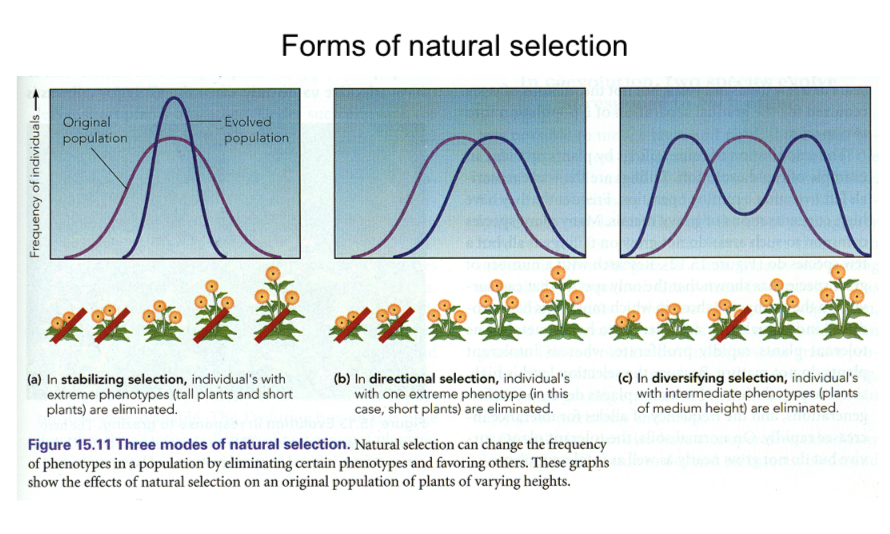
Polymorphism
-Many types
-Diversifying selections acts to make population more diverse
Germination schedules
-Some plants produce seeds with different germination schedules
-Might be result of diversifying selection
-Not all seeds germinate under same conditions
-Always seems to be few seeds out of synchrony with rest
-Might be advantageous
Brief summary of how evolution works
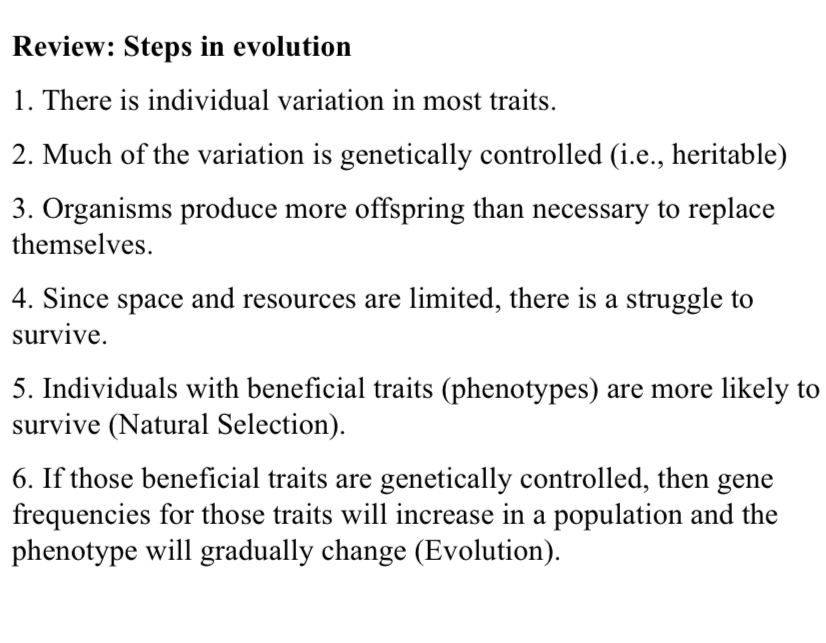
Conditions for evolution NOT to occur

Evolution of Plants: Early Plants
-Early plants had only parenchyma cells, so didn’t fossilize well
-Oldest plant fossils are spores 480 millions years old (Ordovician Period)
-Molecular clocks suggest plants have origin about 550 Mya in Late Precambrian
-Plants evolved from Protists, green algae
Chara
Ancestral living green alga that is most similar to modern plants
-Thought that something like Chara gave rise to plants
-Traits
Photosynthetic with chloroplast, thylakoids, grana, and photo systems
Had chlorophyll a, chlorophyll b, and carotenoids
-Apical meristems and buds and, like early plants, no lateral meristems (no secondary growth)
-Has nodes and internodes
-Had cell walls of cellulose but only primary cell walls
Senses its light environment with phytochrome
-Like early plants, lacks vascular system
-Had sporophyte and gametophyte generations
-Reproduced with spores like early plants
-Differences
Has holdfast instead of roots, no root hairs. This anchors the alga usually onto rocks
No guard cells, stomata, or leaf atmosphere
Deposits minerals in its cell walls
Lacks leaves
No cuticle
-Reproductive structures: Oogonium and antheridium
Basic Geological Time Scale
-Oldest fossils (tetras spores) are from the Ordovician, molecular clock suggest date of 550 mya in late Precambrian
Algae existed before Ordovician

Ordovician period
-443-488 mya
-Ordovician: Ozone allows first land plants shared derived trait: waxy cuticle
-First land plants appear
-Primitive fungi and sea weed appears
-Oceans are full of corals, mollusks, worms, primitive fish, and echinoderms like starfish
-Marine life flourishes
-Most life was under water
-Plants probably looked like bryophytes
Silurian
-425 Million years ago
-Plant life: Small, fragile, and at the margins of water
-Cooksia: early vascular plant. Swollen tips are sporangia
Devonian
-380 mya
-First tetrapods emerged from water
-In beginning, number of species of plants in three different phyla, Rhyniophyta, Zosterophyllophyta, and Trimerophytophyta, had colonized marshy landscapes
-Drier landscapes away from water were devoid of life
-By end of period, most species of marsh plants were extinct
-Transition from green algae to these plants are unknown and whether they occurred once or multiple times
-flowers evolved much later, and colorful structures on plants were sporangia, and also lacked leaves.
-Some primitive plants still exist
-Leaves evolved during this period
Carboniferous Period
-Around 300 Mya
-By Carboniferous (Late Paleozoic) these were trees: ferns, pregymnosperms, and gymnosperms
-Secondary growth evolved
Permian period
-300-250 Mya
Triassic
-230 Mya
-Araucaria
Jurassic
-175 Mya
-There’s cycads which still exist
Cretaceous
Things looked more modern
Flowering plants by Cretaceous
Late Cretaceous 100 Mya
Tertiary
After 66 Mya
Dinosaurs were gone and mammals began to take over
Earliest plants
-Earliest plants were non-vascular
-Small, aquatic, and soft-bodied
-Ulva is a green algae, like Chara
-Ulva life cycle
There is alternation of generations, but can’t tell sporophyte from gametophyte
Alternation of generations was inherited from algae
Zoospores tie Ulva to Protists
No distinct sexes (+,- spores and isogametes)
Zygote is unprotected
Most ancient plants today
-Bryophytes
-Bryophytes don’t fossilize because they only have soft tissues, but their fossil record goes back to Carboniferous
-In early Paleonzoic, bryophytes were only a few centimeters tall
Moss gametophytes
-Some moss are not moss
-Mosses are variable in their gametophytes
-Sphagnum bog are dominated by mosses
Decompose to form peat, a form of low-grade fuel
Peat mines are very acidic so nothing decomposes
-There’s male and female gametophytes but they look similar
The non-motile eggs are slightly bigger than the sperm
-The sporophyte is produced at the top of female gametophytes after fertilization occurs
-The gametophyte consists of rhizomes, bracts, and a thallus
-The sporophyte consists of a seta, capsule, operculum, and sheath
Moss life cycle
-Alternation of generations
Moss spores produce a plant, the gametophyte
-Sexes are present, but not strongly distinct
-Sperm fertilizes eggs to form a zygote (beginning of sporophyte)
-Embryo does not have a dormant or mobile stage
-Fertilization occurs inside droplets of water
-Moss sperm are flagellated, attracted by chemicals released by the egg
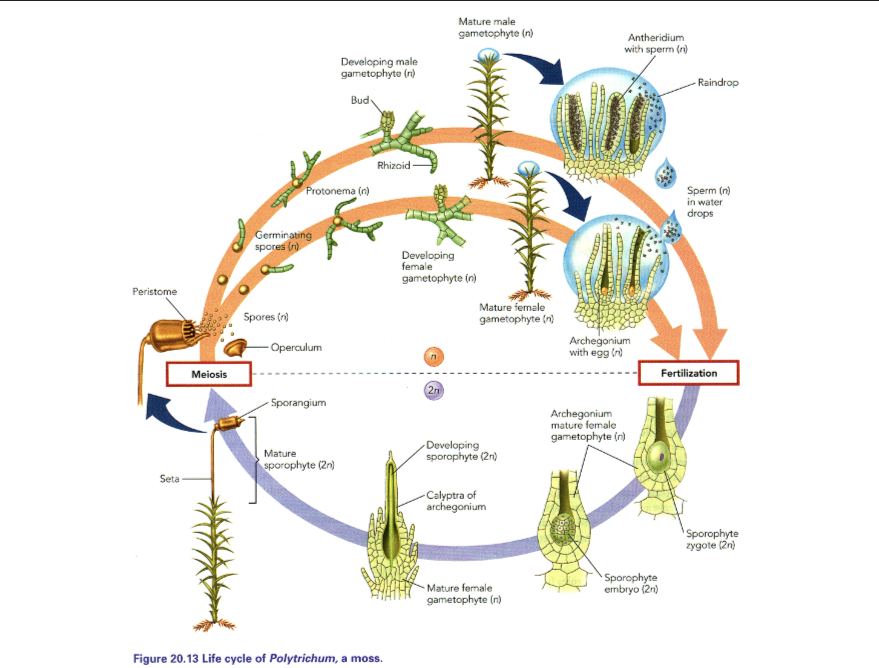
Desert ferns
-Small and grow on the north side of rock outcrops
Tree ferns
-In the tropics
-Tree ferns are 4-6 m tall
-Fern fronds unroll
The Devonian
-Called the Age of Fishes: Only vertebrates on land were early amphibians
-Mid Devonian: 385 mya
-Ferns first appeared here
Fern Life Cycle
-Spores germinate into a plant (gametophyte) called a prothallus
-Prothallus produces both eggs and sperm
-Fertilization occurs under the prothallus where its cool and moist (water is needed for reproduction but not much)
-Young sporophyte grows from under the prothallus
-When fern is mature, produces sori under the leaves, which release spores
-Spores are dispersed ballistically and then by the wind
-The prothallus
The archegonia produce eggs, and the antheridia produce sperm
-Ferns lack a dormant, mobile seed stage. Dispersal is by spores
-Ferns are seedless vascular plants
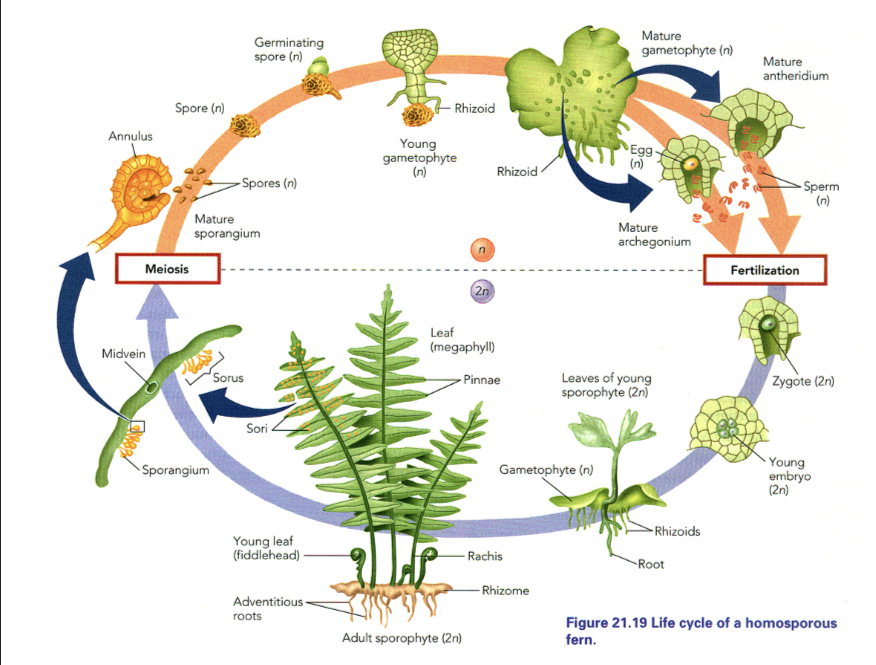
Seed ferns
-Group of extinct plants called seed ferns
-Looks like ferns but not
-Are gymnosperms
Other groups of seedless vascular plants

Whisk ferns
-Not true ferns
-About 100 species worldwide
Club mosses
-Not mosses, but vascular plants without seeds
-Selaginella is common in eastern forests, and looks like a seedling gymnosperm.
-Lycopodium is another common plant of eastern forests
Best in moist forests
About 1300 species worldwide
Date from Silurian
Reproduce by producing cones that release spores
Some grew to trees up to 160 feet tall. Coal beds on eastern United States are made from these trees
Lepidodendron is another group that contribute to coal beds
Horsetails
-Living seedless vascular plants, and these are most familiar
-Only about 15 species worldwide
-Vegetative form has needlelike leaves
-Reproductive form; spore ‘cones’ at top but no leaves
-Strobili are like pollen cones of pines, but produce spores instead of pollen
-Calamites is horsetail tree that’s 50 ft tall
Lived in tropical forests
Contributed to coal deposites
Evolutionary history of gymnosperms
-365 mya
-Confusing
-Some of first ancestors of gymnosperms are called Progymnosperms
Were woody trees that resembled a fir or hemlock tree
Did not have cones
Reproduced with spores, like ferns
-True gymnosperms have cones that produce seeds
-Living taxa are about 630 species

Cycadophyte
-Type of gymnosperm called cycads
-Looks like palm tree that produces cones instead of fruit
Welwitschia mirabilis
-Gnetophyta includes Welwitschia
-Living fossil and only member of its group
-Found in southwest Africa
-Some individuals are thought to be over a thousand years old
-dioecious: female and male cones
Ephedra
-Other member of Gnetophyta
-Common one in Nevada is called Mormon tea or joint fir
Dioescious
-About 50 species worldwide and about 15 in North America
Ginkgophyta or Ginko
-Living fossil from 279 mya
-Found in China but planted widely as shade trees
-Only member of its group
Coniferophyta or conifers
-Includes all of the other gymnosperms (pines, hemlocks, firs, spruces, redwoods, sequoias, junipers, cedars, etc.)
Gymnosperms and secondary growth
-Gymnosperms and their ancestors, progymnosperms, were among first plants to exhibit secondary growth
-No annual or herbaceous gymnosperms
All are shrubs or trees
-First known tree was gymnosperm that looks kinda like a palm tree
Gymnosperms and drought
-Gymnosperms are adapted to drought conditions
-Have sclerophyllous needles instead of broad leaves, recessed stomata, a double layer of epidermis (epidermis and hypodermics), vascular bundles surrounded by endodermis, and xylem made of tracheids
-Endodermis, has something similar to Casparian strip around vascular bundles
All of these traits act to slow water loss and make gymnosperms adapted to arid environments. But these traits cause growth to slow down
Life cycle for pines
-Not divided in halves, with gametophyte generation and sporophyte generation like ferns and mosses
-Gametophyte (pink) takes up smaller portion than sporophyte (blue) generation
-Meiosis produces spores, but spores don’t produce a plant. Instead, produce a gametophyte that lives inside sporophyte.
-For male, pollen grain and pollen tube
-For female, cluster of cells that surround egg called meagametophyte
-Embryo has dormant stage called the seed. When spore no longer established a plants the role of plant dispersal had to be taken over by embryo
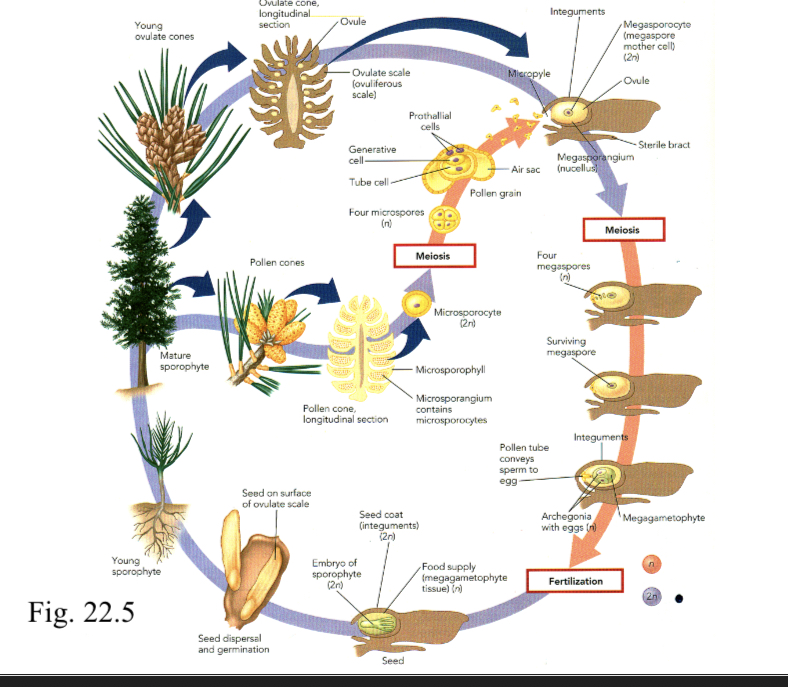
Spores of pines
-Spores have evolved into the pollen grains, later produces pollen tube
-The sperm live within the pollen tube, to be sheltered from external environment to increase successful fertilization
-Also takes no free water
-Pollen tube is the way that plants evolved to be free of water for reproduction and to provide more sheltered environment for the sperm
-Seeds of gymnosperms are naked, not inside a ripened ovary
Embryo of ferns is neither dormant nor mobile

Cretaceous: Flower and Leaf
-Angiosperms evolved during the Cretaceous, and oldest angiosperms are 142 Mya (About 76 million years before dinosaurs went extinct, but after birds evolved)
-Angiosperms radiated rapidly to become dominant group of plants, nearly 250,000 species
-Now: Angiosperms include large trees and competitively superior plants
-Success is largely due to efficient vascular system, including vessel elements and other traits
-Vascular density of angiosperms is much greater
Angiosperms and growth
-Branching pattern of gymnosperms is geometric, whereas branching of angiosperms is more variable
-Gives angiosperms ability to shape themselves to available space
-Many angiosperms, especially those in seasonal environm,ent, drop leaves (deciduous) in cold or dry season.
Trait is uncommon in gymnosperms.
Angiosperms annual lifestyle
-Many angiosperms evolved annual lifestyle
-Means they live less than a year and spend years as seeds in soil seed bank
-No other plants do this.
-These plants die intentionally
-Before angiosperms, plants occupied space and then held on to it as long as possible
Angiosperms and animal interactions
-Angiosperms have more mutualism if interactions with animals
-These interactions benefit both the plant and the animal
-For ex: animals eat fruit to obtain nutrients and disperse the seeds of those plants in the process
-Pollination:
Animals get nectar and pollen while plants get their stigmas pollinated
Interactions had to wait until advanced animals (birds, mammals, bees) evolved
Flower structure evolved, partially in response to pollinators
-Fruits evolved to protect seeds and increase the probability of seed dispersal
Embryo
-In algae, embryo is on a stalk, exposed to the environment
-In mosses and ferns, embryo is somewhat more protected but not greatly
Life cycle of angiosperms
-Similar to gymnosperms
-Gametophyte generation is reduced and internalized
-The gametophyte consists of the pollen and pollen tube in male and female gametophyte (8 cells, megametophyte) in the female
-The pollen tube guides two sperm from the stigma to the ovule

Pollen formation
-Spores divide a couple of times and become encased in a protein cover called the exile to become pollen grains
-The pollen tube enters at the gap between the integumentary called the micropyle
-Female gametophyte consists of 8 cells
-The megastore divides into four cells, but three are very small, called polar nuclei
-This conserves resources in megastore
-The three polar bodies disintegrate
-Megaspore goes through three more mitosis divisions, resulting in 8 cells
-The eight cells become 3 antipodal, 2 synergies, 1 egg, and 2 polar nuclei in the center
Double fertilization
-In plants, double fertilization
-Two sperm arrive at the female gametophyte in the pollen tube
-One fertilizes the egg (to make zygote) and the other fertilizes the two polar nuclei (to form endosperm; 3N)
-The zygote grows into the embryo, consisting of a radicle, epicotyl, hypocotyl, and two cotyledons
-8 suspensor cells support the heart0shaped embryo
-In mature mustard seeds, the cotyledons fold over
Early development of a Dicot
